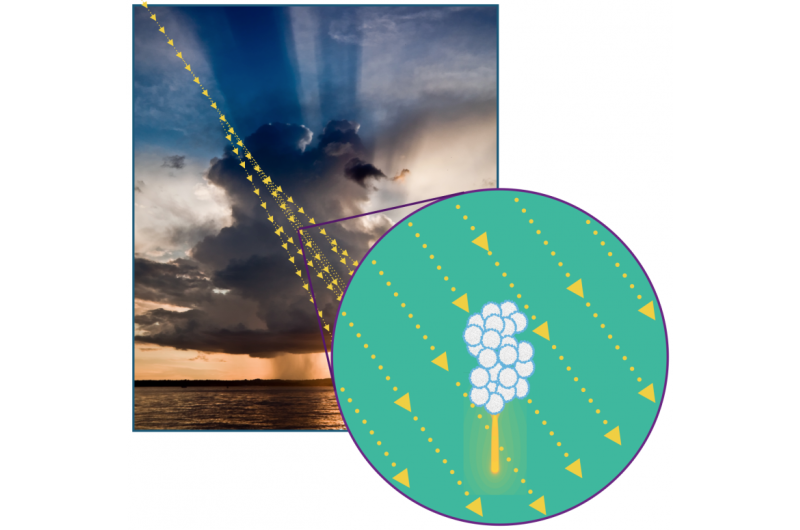A cosmic particle produces a particle shower, which generates free electrons. As soon as these electrons are available, a streamer discharge starts growing from a large hailstone, where the electric field of a thunder cloud is amplified. Credit: CWI.
Even though lightning is a common phenomenon, the exact mechanism triggering a lightning discharge remains elusive. Scientists at the Dutch national research institute for mathematics CWI, the University of Groningen and the University of Brussels now published a realistic model involving large ice particles and cosmic rays.
The big picture of lightning is clear: charge separation occurs inside a thundercloud and is eventually short-circuited by a conductive tube of ionized air. However, the electric field inside these clouds is usually an order of magnitude too low to create the conductive tube. This is why lightning inception is first out of the 'top ten questions in lightning research', according to a recent review.
Lightning researchers at CWI (Amsterdam), the University of Groningen (KVI-CART), and the University of Brussels now claim to have cracked this question. Large ice particles or hydrometeors form the first ingredient of their model. These grow out of hailstones moving up and down in the turbulent air inside thunderclouds. When they grow in an elongated shape, this will focus the electric field inside the cloud on their tips. The increased electric field is high enough to accelerate free electrons and start an ionization cascade, necessary to create a conductive tube.
Simulations showed that ice particles of 6 cm length and a narrow, elongated shape would increase the electric field enough to cause discharge inception. Estimates from the literature suggest such hydrometeors occur inside thunderclouds in a density of roughly 0.1 m-3.
Normally there are too few free electrons present in the surrounding air to cause a discharge. However, these could be provided by high energy cosmic rays, which can generate large showers of free electrons. Computer simulations showed that in an electric field of 3 meters high and 0.2 km2, one air shower per minute of free electrons capable of discharge inception would occur.
In short, free electrons from air showers caused by cosmic particles entering the atmosphere are accelerated in the electric field at the tip of a hydrometeor, and form self-propagating tubes of ionized air. These conductive tubes can short-circuit the built-up charge difference inside a thundercloud, between clouds or between a cloud and the earth's surface. The results, presented in a Physical Review Letters paper, show that this mechanism for discharge inception is realistic.
The proposed model would predict that lightning inception at higher altitudes (e.g. 12 km) is less likely, as the hydrometeors would have to be longer to reach the required electric field density, while electron density in air showers caused by cosmic particles is lower at this altitude.
If these results are confirmed, a big question will have been solved. However, professor of particle physics Olaf Scholten, says there are still plenty of questions remaining. "Our institute is using data from large radio telescopes, like the Dutch Low Frequency Array LOFAR, to study lightning and increase our understanding of this phenomenon." Future projects include studying the charge separation in clouds and the location of the discharge inside a cloud.
The study was partly funded by the project 'Creeping Sparks' from Technology Foundation STW and 'Cosmic Lightning' from the Foundation for Fundamental Research on Matter (FOM).
More information: 'Prediction of lightning inception by large ice particles and extensive air showers', Physical Review Letters, 30 June 2015. dx.doi.org/10.1103/PhysRevLett.115.015002
Journal information: Physical Review Letters
Provided by Fundamental Research on Matter (FOM)























